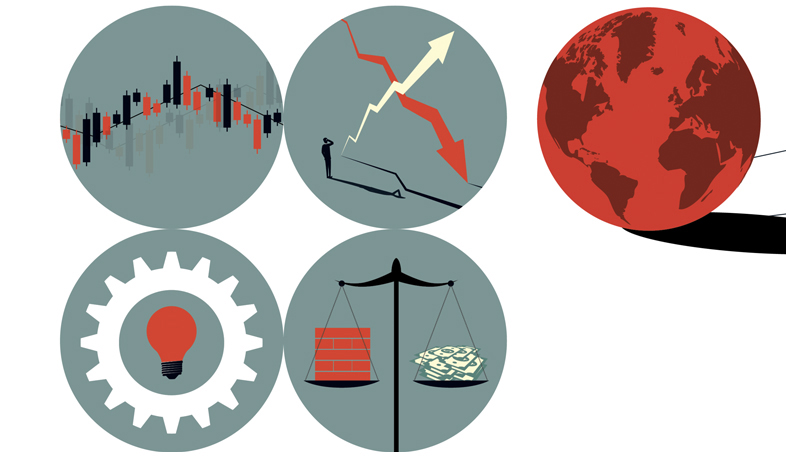
By Carlos Fuentes
Editor’s Note: This is the first of a two-part series examining the dynamics of market forces that govern the economy, which is the stage in which actuaries operate.
The historical development of utility, supply, and demand concepts in the 19th century enables us to better understand the current dynamics of market forces.
——–
Key Takeaways
- This article summarizes the history of supply and demand pricing, also known as economic pricing, through the end of the 19th century.
- The development of supply and demand concepts over millennia highlights their counterintuitive nature and helps explain why the limitations of supply-demand pricing are often misunderstood.
- There may not be a better way to appreciate the power and limitations of economic pricing than by reviewing the conundrums faced by economists and their solutions to these challenges.
- Although actuarial pricing is typically performed on a cost-plus basis, there are situations where the practicing professional can benefit from an understanding of supply-demand pricing (also known as economic pricing), such as in competition-based health insurance.
——–
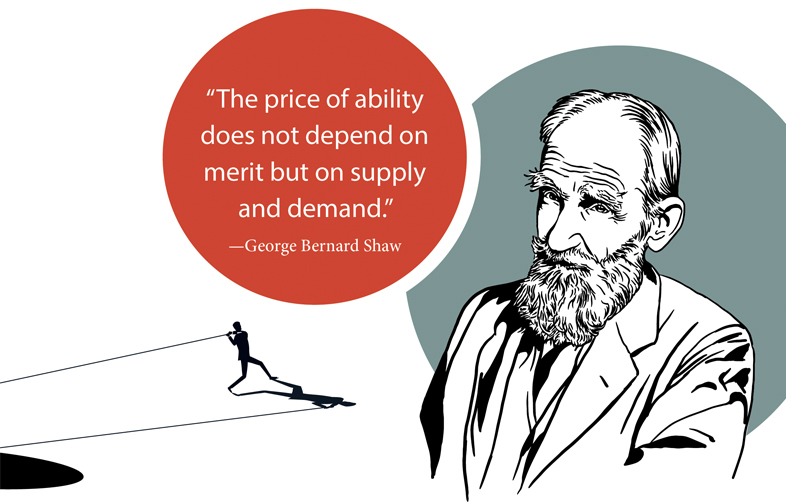
The dynamics of market forces have long intrigued economists and thinkers alike. This article delves into the historical development of the concepts of supply and demand, shedding light on how these forces shape the pricing of goods and services. It examines the perplexing questions of why certain essential goods are inexpensive while some superfluous items command high prices, and touches upon other issues such as government intervention in markets.
Through a historical lens, the article explores the fundamental principles of utility, demand, and supply, offering readers a deeper understanding of the complex mechanisms that govern our economy. It highlights the contributions of Adam Smith, Karl Marx, David Ricardo, Carl Menger, and William Stanley Jevons, and covers topics such as usury, the legitimacy of wages and prices, rent (a term often misunderstood), and capital, emphasizing the roles of labor, utility, and marginal utility. This sets the stage for the great synthesis accomplished by economist Alfred Marshall in the upcoming second and final article, which will focus on fundamental economic questions and illustrate how supply and demand concepts are used to price products and services.
Understanding market dynamics and economic pricing allows actuaries to make informed judgements about competitive markets. For example, in competition-based health insurance, actuaries need to consider the supply of insurance services and the demand for insurance coverage. Grasping the interplay of these factors and their associated assumptions allows actuaries to form solid opinions.
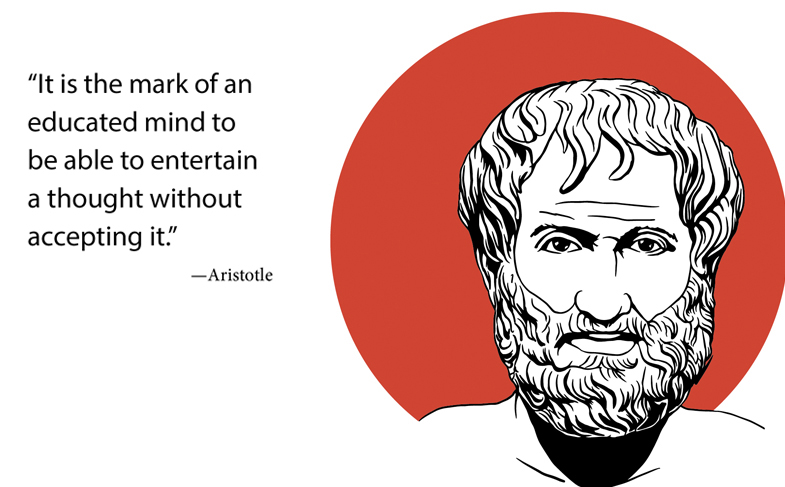
In the Beginning…
Aristotle[1] in the fourth century BCE, along with other philosophers before and after him, examined the question of fairness in price. Because slavery was accepted in Ancient Greece and because production was confined to what households could manufacture, considerations on interest, wages, and labor costs were not part of the economic discussion. Prices were derived in one way or another from production costs, and production costs were not a visible function in the slave-owning household. Even so, there were questions that puzzled thinkers for thousands of years, particularly the following: Why are some of the most useful things the least valuable in the market, while some of the least useful command high prices?
Theologians and philosophers expressed strong opinions on topics that in current terms could be referred to as political economics[2] such as the legitimacy of prices (including how much should be paid for the satisfaction of vices[3]), usury[4] (what we now call interest on loans), and population growth (its effect on the depletion of resources[5]). Although their views may appear quaint to readers today, their relevance cannot be denied.
Adam Smith[6]
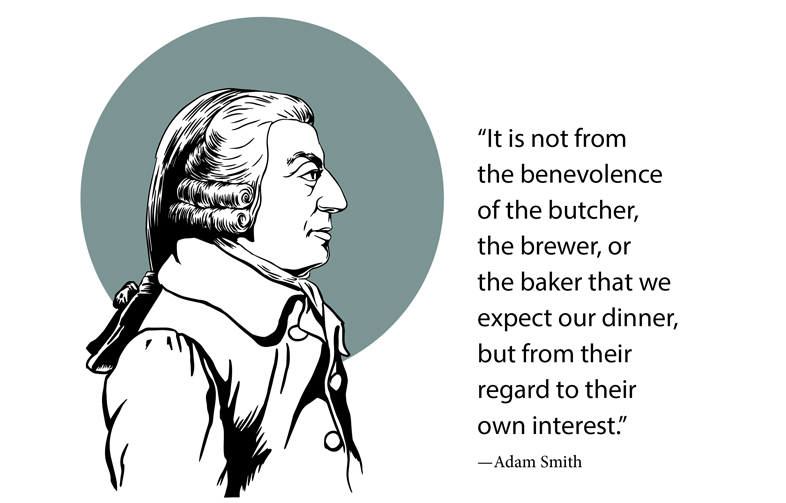
Advances in economics were slow.[7] In 1776, Adam Smith published his famous work, The Wealth of Nations, in which he postulates that value, what he called natural price, was the sum of the costs of production. The worker transforms raw materials purchased by the capitalist using equipment owned by the capitalist. The worker is paid by the hour for his labor (wages) while the capitalist is paid by the amount of capital[8] and the length of time in the production process. When production involves the use of land, a third component must be included in the price of production: the rent[9] of the land. Anything the capitalist purchases from other capitalists is in essence labor, profit, and rent. By far, the most important component is labor, so much so that economics (or microeconomics, as we would say today) and theory of value were considered synonyms of labor theory of value.
Smith next tackled the problem of income distribution: When a product is sold, how much of the sale price should go to the workers, the capitalists and, if land is involved, the landlords? According to Smith, wages can be quantified by the workers’ and their families’ costs of subsistence, which determine the minimum wage. This idea gave rise to the subsistence theory of wages, which was to be further developed by other economists. With clear insight, Smith reasoned that wages cannot be much higher than the minimum due to the disparity in bargain power between the worker and the capitalist (and the landlord), except when labor was scarce, but this situation is only transitory as higher wages attract more workers.[10]
Smith struggled with the natural rate of rent (landlord’s profit) and the natural rate of profit (capitalist’s profit). He reasoned that since value is ultimately the result of labor, the capitalist must extract a portion of the value produced by the worker. The lower the wages the more surplus[11] the capitalist can extract. This observation would become a major source of the revolutionary indignation to Karl Marx and a much more potent catalyst for social action than Marx’s economic theory, which most critics believe was obsolete by the time the first edition of Das Kapital went to print. About 100 years later,[12] Milton Freeman proposed a somewhat similar idea in The Social Responsibility of Business is to Increase Its Profits,[13]an article that appeared in the Sept. 13, 1970 issue of The New York Times.
Smith understood that his theory could not explain why some nearly essential things in life are free or almost so while others that are unimportant command high prices. He attempted to solve the puzzle by making the distinction between value in use–what has been explained above–and value in exchange. Understanding the baffling value in exchange had to wait over a century for the introduction of the idea of marginal utility, which is based on the concept of derivative.
Karl Marx[14]
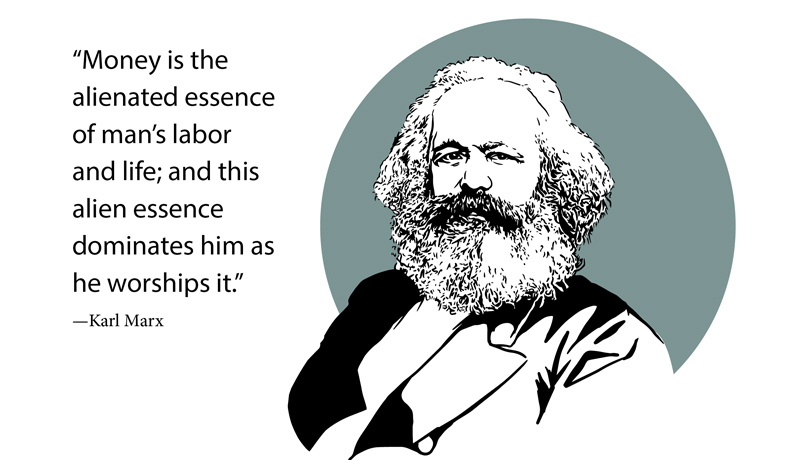
According to Marx, in early economies, sales occurred only to facilitate later purchases. The cycle was Commodity-Money-Commodity (C-M-C) and the nature of the transaction was barter. Capitalism introduced a variant, M-C-M, a cycle in which money was advanced by the capitalist with the object of recovering it, not with the purpose of purchasing a good. Since the capitalist aimed at profit, capitalism transformed the cycle to M-C-M’, where M is the capitalist’s original monetary outlay, m is the transaction’s profit, and M’ = M + m. This profit (m), Marx labeled surplus value. Marx assumed that labor was the unique commodity capable of creating value. Because only labor created value, the workman was entitled to the whole product of his labor. Actually, he received only that portion of his labor necessary for his subsistence and reproduction. The remainder, surplus value, comprised profits, interest, and rent.
The sum of necessary labor time and surplus labor time constituted the working day. The longer the day, the greater the surplus values produced. Therefore, it was in the employer’s interest to increase the working day as much as possible and in the workman’s interest to shorten it. When the capitalist was thwarted in his efforts to increase the working day (e.g., by legislation that shortened the working day), he shifted his attention to the creation of surplus value generated with reduced amounts of socially necessary labor time. Such is the explanation of greater mechanization, improved technology, and persistent efforts to cheapen food.
Whereas Ricardo believed that the owners of machinery deserved a reward for employing it, Marx believed that the machine could do no more than transfer the value in it, the hours of socially necessary labor time consumed by its creation to the finished product. Machinery demanded a disciplined work force and central factory control. One day, workers could employ their training to overthrow their employers. For this day of deliverance, strikes were a preparation and their bloody repression a lesson in class consciousness.
David Ricardo[15]
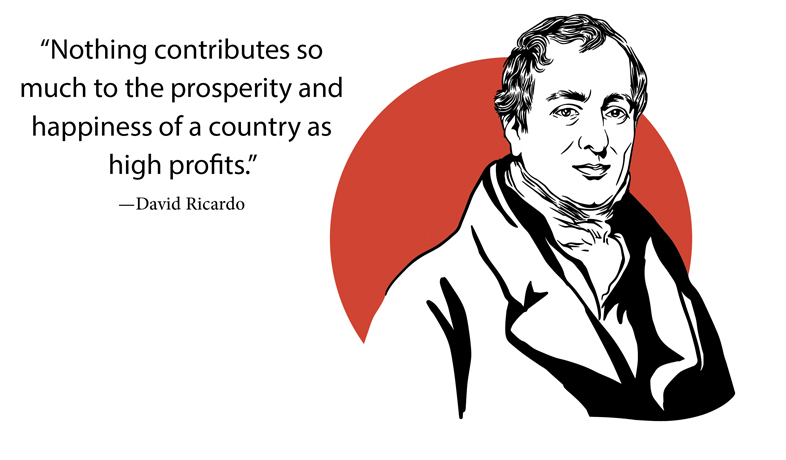
The next important event in the history of economic value as described in this article is the publication of labor theory of value in which its author, David Ricardo, did two things. First, he identified the role of usefulness (utility): “If a commodity were in no way useful-in other words, if it could in no way contribute to our gratification-it would be destitute of exchangeable value.” Ricardo then explained in his famous work, Principles of Political Economy and Taxation, that utility (demand) alone does not determine value; instead, it must be combined with the second element, supply: “He[16] certainly has not a correct notion of what is meant by value when he contends that a commodity is valuable in proportion to its utility. This would be true if buyers only regulated the value of commodities; but the fact appears to me to be that the buyers have the least in the world to do in regulating price-it is all done by the competition of the sellers.” He further asserted that the value of exchangeable products[17] comes from scarcity or from the quantity of labor required to obtain them. The market determines the relative wages of different types of labor (e.g., accounting and actuarial science) with sufficient precision for all practical purposes; they depend on the comparative skills of the laborer and the intensity of the labor performed. The scale, once formed, is liable to little variations.
In a passage greatly quoted, known as the iron law of wages, Ricardo defines wages as “the price which is necessary to enable the laborers, one with another, to subsist and to perpetuate their race, without either increase or diminution.” In modern lingo, the iron law is the equilibrium price of labor, which includes “conveniences that become essential to [the worker] from habit.” In other words, wages support the conventional standard of living, but such conventions depend on factors such as country of residency. In an excerpt that remains relevant to public policy, Ricardo stated that “when, however, by the encouragement which high wages give to the increase of population, the number of laborers is increased, wages again fall to their natural price, and indeed from a reaction sometimes fall below it […] Like all other contracts, wages should be left to the fair and free competition of the market and should never be controlled by interference with legislature.”
Carl Menger[18]

“There is no better means of reducing a fallacious variety of thought to absurdity than to let it live itself out completely.”-Carl Menger
Carl Menger is renowned for founding The Austrian School of Economics.[19] His seminal work, Principles of Economics, published in 1871, introduced the concept of marginal utility which revolutionized economic thought. Menger argued that the value of a good is determined by its marginal utility, which is the additional satisfaction or benefit derived from consuming one more unit of the good. Menger’s theory states that value is subjective and depends on the individual’s assessment of the additional utility gained from the last unit consumed. This subjective theory of value emphasized that value is not inherent in goods but is determined by individual preferences and the context of consumption.
Menger’s work laid the foundation for the marginalist revolution in economics, which shifted the focus from labor and production costs to individual preferences and utility. His contributions also influenced the development of the theory of price formation and market processes. Menger’s insights into the role of information and knowledge in economic decision-making further enriched the understanding of market dynamics.
William Stanley Jevons[20]
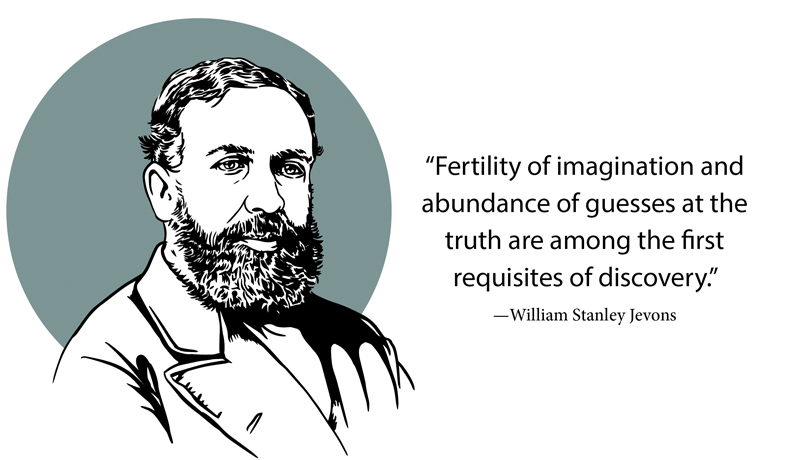
Jevons independently developed the theory of marginal utility around the same time as Carl Menger. Jevons’ major contribution to the theory of supply and demand includes his formulation of the law of diminishing marginal utility. Jevons introduced the concept of the equation of exchange, which describes the relationship between the quantity of goods and their prices in a market. His work helped to formalize the mathematical analysis of economic behavior and contributed to the development of the marginalist revolution in economics. In his book, The Theory of Political Economy, published in 1871, Jevons emphasized the importance of utility in economic analysis and laid the groundwork for the marginalist approach. He also explored the often-ignored role of time and uncertainty in economic decision-making, highlighting the dynamic nature of markets.
Jevons’ contributions extended beyond the theory of supply and demand, as he made significant advancements in the fields of statistics and econometrics. His work on index numbers[21] and the measurement of economic variables provided valuable tools for empirical analysis.
Final Remarks
Grasping the basic concepts of economic pricing is essential for professionals, including actuaries, who operate in the financial sector because such notions offer valuable insights into how pricing mechanisms operate in broad economic contexts. The slow development of utility, supply, demand, and related ideas is due in part to certain counterintuitive aspects that surrounds them and to complexities that were addressed with assumptions whose validity is seldom questioned. It is not surprising, therefore, that many economic beliefs are unfounded and that predictions are seldom confirmed within a reasonable range of validity.
Actuaries who grasp the concepts briefly reviewed in this article are equipped to make better judgments on issues that involve supply and demand, such as health provider competition, and to understand the innovative solutions economists have devised to address the puzzling problem of value. Actuaries can also incorporate elements of these economic tools to their models, making them more useful.
Carlos Fuentes, MAAA, FSA, FCA, MBA, MS, is president of Axiom Actuarial Consulting. He can be reached at carlos-fuentes@axiom-actuarial.com.
Endnotes
- Aristotle (384-322 B.C.E.) was a Greek philosopher and polymath, a student of Plato and tutor to Alexander the Great. He made foundational contributions to various fields, including ethics, politics, metaphysics, and biology, shaping Western thought and philosophy for centuries.
- Political economics examines the interplay between politics and economics, focusing on how political institutions, policies, and processes influence economic behavior and outcomes. It explores the impact of government actions on economic performance, distribution of resources, and societal welfare.
- Many argue that vices can harm individuals and society, leading to questions about the morality of profiting from them. This perspective emphasizes the duty to promote well-being rather than exploit weaknesses. Others believe that individuals know better than anybody else what they value; consequently, they should have complete freedom in their decisions.
- The Torah explicitly forbids charging interest in some circumstances (Exodus 22:25). This principle is reinforced in various Talmudic discussions, highlighting the moral imperative of helping those in need without exploiting them financially.
- See An Essay on the Principle of Population by Thomas Robert Malthus. The subject is relevant once again and it is becoming more so with the passage of time.
- Adam Smith (1723-1790) was a Scottish economist and philosopher, best known for his seminal work, The Wealth of Nations. He is often regarded as the father of modern economics, advocating for free markets and the division of labor. His ideas laid the foundation of classical economics and capitalism.
- Important discoveries in physics in the 18th century include Lagrangian mechanics and the conservation of mass. Newton formulated the theory of gravitation in 1687.
- Economic capital is a term commonly misunderstood. It refers to assets used in the production of goods and services such as raw material, machinery, means of transportation, and communication. Capital has a number of related meanings in economics, finance, and accounting. In finance, accounting, and in general parlance, it generally refers to financial wealth.
- Rent, as originally uwnderstood, was caused by the pressure of population on the means of subsistence. Population growth presses cultivation to even poorer land. Such pressure continues until the increasingly desolate soil returns only the minimum necessary for the lives of those who work it; that minimum then determines in a general way the wages of those who work the land. From possession of the better land comes a surplus over cost. This is greater when the land is better and as the population grows. The owner of good land is thus the beneficiary not only of her own good fortune but also of the increasing misery of others. In modern economics, rent is defined as an extension of the concept just described, that is, the difference between the total return to a factor of production (land, labor, or capital) and its supply price.
- Regulations and unions strengthen the bargaining power of workers and distort the free market which depending on the circumstances and the views of the actors involved can be unfair and inefficient, just and socially desirable, or both.
- Surplus is the amount of an asset or resource that exceeds the portion that is utilized.
- Milton Friedman (1912-2006) was one of the leading proponents of monetarism and free-market capitalism. A libertarian, he won the Nobel Prize in Economics in 1976 for his research on income and consumption.
- The thesis of the article can be summarized as follows: executives are employees of the owners. They are required to deliver quality service to the employer first before any other party. An entity is not obligated to any social responsibilities unless the shareholders decide otherwise.
- Karl Marx (1818-1883) was a German philosopher, historian, sociologist, and political theorist. His two most famous works are The Communist Manifesto and Das Kapital. The Columbia History of the World called Marx’s writings “one of the most remarkable and original syntheses in the history of human intellect.”
- David Ricardo (1772-1823) was one of those rare people who achieved tremendous success and lasting fame. After his family disinherited him, Ricardo made a fortune as a stockbroker and loan broker. His most important work is in the fields of labor theory of value, the theory of comparative advantage, and the theory of rents. He, among others, enunciated the law of diminishing marginal returns.
- Jean-Baptiste Say (1767-1832) was a French classical, liberal economist, and scholar. Say’s famous law of markets-to which many economists and non-economists adhere-is a foundational concept of classical economic theory; it states that production is the source of demand (“supply creates its own demand”). Like Ricardo, John Maynard Keynes, one of the greatest economists in history, argued that demand, not supply, drives economic activity.
- The idea of exchangeable products is important because it excludes from the analysis non-reproducible commodities such as works of art, and hints at the relationship between supply and demand.
- Carl Menger (1840-1921) was an Austrian economist who contributed to the development of the marginal utility theory and to the formulation of a subjective theory of value.
- The Austrian School of Economics emphasizes the importance of individual choice, subjective value, and the role of time and uncertainty in economic decision-making. It advocates for free markets, minimal government intervention, and the significance of entrepreneurship in driving economic growth and innovation.
- William Stanley Jevons (1835-1882) was a British economist and philosopher. He is one of the main contributors to the marginal revolution, which shifted classical to neoclassical economics. He was the first economist to construct index numbers, and had a tremendous influence on the development of empirical methods, and the use of statistics and econometrics in the social sciences.
- Index numbers measure the relative changes in various economic variables, such as prices and quantities.